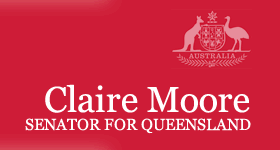Senator MOORE (Queensland) (19:35): I want to make some comments this evening on the Workplace Gender Equality Agency, which as all of us know was created by the Australian government with the Workplace Gender Equality Act 2012. The agency was created to administer that act. It followed on from its previous incarnations as the Equal Opportunity for Women in the Workplace Agency and prior to that the Affirmative Action Agency.
The vision of the agency is for all women and men to be equally represented, valued and rewarded in the workplace. The agency, amongst its many tasks, prepares annual reports on what is happening in Australian workplaces around the issues of equity. There is quite an extensive data collection process, which involves all employers in the private sector and university sector that employ over 100 employees, and this data is collected and then gathered together to provide extraordinarily valuable reports to the Australian community.
When the Commission of Audit was put in place by this government very early in its term, there were a number of issues raised about efficiencies in the public sector, and one of the agencies that seemed to be questioned in terms of its value for purpose was the Workplace Gender Equality Agency. This created an immediate response from women's organisations and business organisations in the community, and an alliance was formed called the Coalition for Working Women. This alliance is made up of the Australian Local Government Women's Association, BPW, the Financial Services Institute of Australasia, Local Government Managers Australia, the National Council of Women of Australia, the National Foundation for Australian Women, the Work and Family Policy Roundtable at the University of South Australia, Women on Boards, the Women's Electoral Lobby, YWCA and the ACTU, who gathered together because they understood that there was a real value in the work that the agency did. They did not wish it to be subsumed into any other organisation or somehow displaced in its importance. So there was immediate lobbying. I think the minister, Minister Abetz, was impressed by the advocacy that he received from this group and, as a result of discussions, implemented an inquiry to look at the reporting processes of the agency.
This was a widespread inquiry which got representation from business organisations, women's groups, people who were interested in what the agency did and what the report should entail. Out of that research came some changes to the way that reports will operate. On 25 February, Senator Abetz and Senator Michaelia Cash announced changes to the workplace gender equality reporting requirements. There is no change, most importantly, to the act. It will continue to apply to all employers in the private sector and higher education with 100 or more employees. Employers will continue to provide information against six gender equality indicators: gender composition of the workforce; gender composition of governing bodies; equal remuneration between men and women; availability and utility of employment terms, conditions and practices relating to flexible working arrangements; consultation with employees on issues concerning gender equality in the workplace; and sex based harassment and discrimination in the workplace.
The changes will occur for the reporting period 2015-16. Employers will be required to provide detailed information about their employee groups by gender, manager or non-manager occupational category and employment status; management categories and reporting distance from the CEO; annualised average full-time equivalent base salary and total remuneration for employees; and the gender composition of governing bodies. That is looking particularly at the vexed issue of the gender gap in Australia. I will get onto that, because one of the core aspects of the agency's job is to look at the issue of the gender pay gap in Australia.
One of the things that came out of the consultation was: we know there is a gender pay gap; in fact, it is over 18 per cent at the moment-the last report, from 2014, said it was 18.8 per cent-and it has been staying at this high level for a considerable period of time. Everybody knows it exists. Everybody knows it is bad. No-one actually says that they like a gender pay gap. There just seemed to be some concern from employers about what they had to do to make it go away, what kinds of reports they needed to provide and what their responsibility was as employers to look at gender pay gaps or gender variations in the wages and conditions of their employees.
The Workplace Gender Equality Agency provides a report annually on what the current status is of the gender pay gap and does an analysis based on the reports that have been provided to it across industry, across region, across level, to see where these gaps actually are. That is such a valuable tool. Having this information is not an end in itself; it is a tool for all of us in the community, in the business community, in parliament and in employer and employee organisations not only to see and acknowledge that the gender pay gap is wrong-and it is palpably wrong-but to see what is actually happening in the workplaces which can cause this inequity to happen.
Not only are employers asked to put information down about the actual wages; they also need to look at parental leave and the take-up of those provisions; availability, conditions and practices relating to flexible working arrangements; consultation undertaken with employees on workplace gender equality; grievance processes; and the existence of strategies or policies to provide real, practical support in the workplace about: gender equality; selection for governing body members; equal pay, including bonuses and access to overtime; flexible working arrangements; and the very important aspect of sex based harassment and discrimination. And now, as part of our National Plan to Reduce Violence against Women and their Children, employers are asked to put information down about family or domestic violence processes, strategies and support mechanisms they have in their workplaces. This, gathered together with the particular data about pay rates, builds a picture about what is happening in individual workplaces, what works and what does not and how we can together bring down this horrific pay gap-which is across the board; every industry expresses that there are some issues around gender pay inequality in their industry-how we can work together to find out why it happens and how to stop it.
The economic benefits to our community are manifold. Everybody understands that, if we can ensure that there is true equity in the workplace, that will create more productivity, the jobs will be more worthwhile and we will be able to build employment processes and an employment model that will ensure that we will encourage and maintain workers at every stage of their lives, because this process operates from the time people come on until the time they retire, whether they choose to retire or it is a process of age discrimination.
It is important that we understand the work that the Workplace Gender Equality Agency does for the community and for workplaces and value the professional skills that it has to provide support to workplaces and to individuals about the best way that we can make workplaces safe, attractive and equal. We are now almost at the stage of looking at the data collection for the next round of reports, and we should have the first round of the reports from the last one made public towards the end of this year. From that, we will be able to have benchmarks to see what improvements have occurred and what needs to happen in the future. This is a proactive element which supports our community.
I particularly want to pay my respects to the women who gathered together so strongly and so quickly when they thought that this valuable agency and the work that it does could be in any way devalued or lost to the ongoing work that we have to do to make sure that that vision of the Workplace Gender Equality Agency-which is to provide workplaces which are equal and safe-is accepted and achieved across Australian workplaces.




